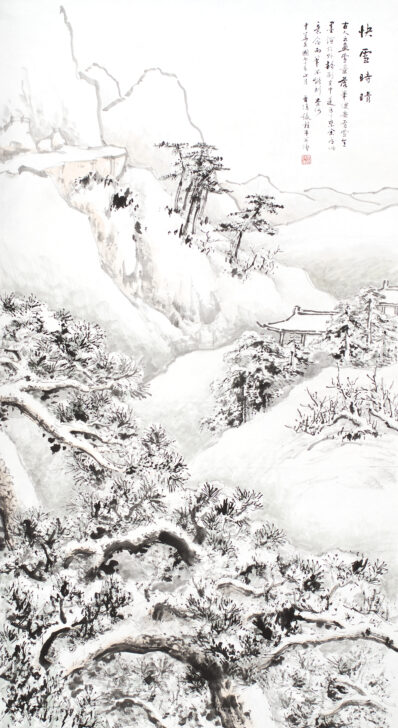Clearing After Snow
Chang Ku-nien

Description
Chang’s inscription on this painting expresses the old masters’ teaching that it is the artist’s goal to capture the “idea” of snow through expressive brushwork. Snow scenes were a favorite subject for Chang and there are several in this exhibition. In some he follows the Song (960–1279) masters in creating bitter wintry scenes in which mountains are covered by snow and dormant trees bear no leaves, resulting in a desolate atmosphere (such as in Snow Scene after Li Cheng). In Clearing after Snow, however, a more vigorous mood is evoked, one that suggests the life beneath the heavy snow; the focus on the durability of pine trees in wintry weather makes them an auspicious subject. Chang employs traditional techniques to render snow, which is indicated not through pigments but by leaving the paper blank and surrounding it with dark ink grading and washing techniques to emphasize its whiteness.
(Tradition Transformed: Chang Ku-nien, Master Painter of the 20th Century, Winter 2010)
Gallery Rotation Winter 2012
Chang Ku-nien
China, 1906–1987
Clearing after Snow
1970
Hanging scroll, ink on paper
Gift of Dr. Cheng-Yang and Mrs. Shirley Chang, 2006/1.110
Chang Ku-nien’s inscription on this painting refers to the old masters’ traditional teaching that it is the artist’s goal to capture the “idea” of snow through expressive brushwork. Here Chang renders it not through pigments but by leaving an area of paper blank and surrounding it with dark ink grading and washing techniques to further emphasize its whiteness. Snow scenes were a favorite subject for Chang. Some of his depictions emulate the Song (960–1279) painters in creating bitter wintry scenes in which mountains are blanketed and dormant trees bear no leaves, resulting in a desolate atmosphere. In this painting, however, a more vigorous mood is evoked, one that suggests the life beneath the heavy snow; the focus on the durability of pine trees in wintry weather makes them an auspicious subject for a painting.
Subject Matter:
Chang creates a bitter wintry scene, evoking a desolate atmosphere. However, the snowy pine scene in this painting, although still intended to follow traditional techniques of painting snow, depicts a more vigorous facet of snow scenery. Underneath heavy snows, the intensive pine needles and dramatic twisting trunks seem to still grow lividly. The durability of pine trees in wintry weather makes the theme of snowy pines a welcoming and auspicious painting subject.
Chang Ku-nien’s inscription on this painting restates/refers to the old masters’ traditional teaching that it is the artist’s goal to capture the “idea” of snow through expressive brushwork. Here Chang renders it not through pigments but by leaving the paper blank and surrounding it with dark ink grading and washing techniques to further emphasize its whiteness. Snow scenes were a favorite subject for Chang. Some of his depictions emulate the Song (960–1279) painters in creating bitter wintry scenes in which mountains are blanketed and dormant trees bear no leaves, resulting in a desolate atmosphere. In this painting, however, a more vigorous mood is evoked, one that suggests the life beneath the heavy snow; the focus on the durability of pine trees in wintry weather makes them an auspicious subject for a painting.
Physical Description:
In this scene mountains and a pavillion are covered by snow and dormant trees bear no leaves. Calligraphic text is in the upper right corner.
Usage Rights:
If you are interested in using an image for a publication, please visit https://umma.umich.edu/request-image/ for more information and to fill out the online Image Rights and Reproductions Request Form.